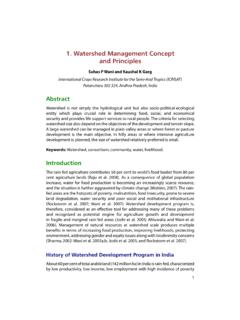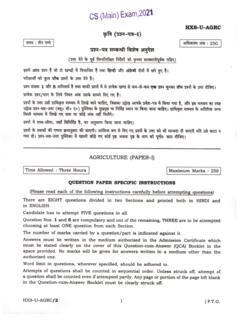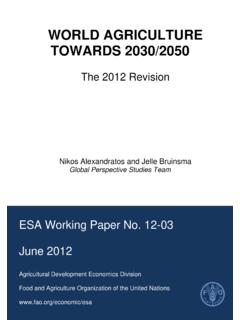Transcription of LECTURE NOTE ON Agron 6.10 RAINFED AGRICULTURE AND ...
1 LECTURE NOTE ON Agron RAINFED AGRICULTURE AND watershed management 6TH SEMESTER (Tech) Agri. DR. K. D. MEVADA Associate Professor Department of Agronomy College of AGRICULTURE Anand Agricultural University Anand DR. Assistant Professor Department of Agronomy College of AGRICULTURE Junagadh Agricultural University Amreli PIYUSH SARAS Assistant Professor Department of Agronomy Patel College of AGRICULTURE Sardarkrushinagar Dantiwada Agricultural University Sardarkrushinagar DESHMUKH Assistant Professor Department of Agronomy College of AGRICULTURE Navsari Agricultural University Bharuch Course No. : Agron Title of Course: RAINFED AGRICULTURE and watershed management Credit: 1+1 = 2 C O N T E N T (THEORY) Unit LECTURE No.
2 Sub topics Page No. I RAINFED AGRICULTURE 1 Introduction, types, History of RAINFED AGRICULTURE in India 1-8 2 Problems and prospects of RAINFED AGRICULTURE in India 9-14 3 Soil and climatic conditions prevalent in RAINFED areas 15-31 II Soil and Water Conservation Techniques 4 Soil erosion; water and wind, Soil and water conservation techniques 32-40 III Drought 5 Types, effect of water deficit on physio-morphological characteristics of the plants 41-45 6 Crop adaptation and mitigation to drought 46-48 IV Water Harvesting 7 Importance, its techniques, efficient utilization of water through soil and crop management practices 49-62 V management of Crops in RAINFED Areas 8 management of crops in RAINFED areas 63-71 VI Contingent Crop Planning for Aberrant Weather Conditions 9 Contingent crop planning for aberrant weather conditions 72-77 VII watershed management 10 History of watershed in India, Concept, objective.
3 Principles and components and Factors affecting watershed management 78-95 Glossary and Abbreviations - - i-x RAINFED AGRICULTURE : Introduction, Types and History of RAINFED AGRICULTURE in India RAINFED AGRICULTURE and watershed management : Mevada K. D., Poonia T. C, Saras Piyush and Deshmukh Page 1 1 RAINFED AGRICULTURE : Introduction, Types and History of RAINFED AGRICULTURE in India Introduction Even after the utilization of all our water resources for irrigation, about half of the cultivated area will remain RAINFED . As there is hardly any scope for increasing the area under cultivation, it is really a colossal task for meeting the future food needs.
4 It is against this background that the role of dryland AGRICULTURE gained importance. AGRICULTURE is the single largest livelihood sources in India with nearly two thirds of people depend on it. RAINFED AGRICULTURE is as old as AGRICULTURE itself. Growing of crops entirely under RAINFED conditions is known as dryland AGRICULTURE . Very often, the words dry farming, dryland AGRICULTURE and RAINFED AGRICULTURE are used synonymously to indicate similar farming situation. Clearly, the two exclude irrigations. Depending on the amount of rainfall received, it can be grouped into three categories: Types of Dryland/ RAINFED AGRICULTURE Definitions a) Dry farming: is cultivation of crops in regions with annual rainfall less than 750 mm.
5 Crop failures is most common due to prolonged dry spells during the crop period. These are arid regions with a growing season (period of adequate soil moisture) less than 75 days. Moisture conservation practices are necessary for crop production. b) Dryland farming: is cultivation of crops in regions with annual rainfall more than 750 mm. In spite of prolonged dry spells crop failure is relatively less frequent. These are semi-arid tracts with a growing period between 75 and 120 days. Moisture conservation practices are necessary for crop production. However, adequate drainage is required especially for vertisols or black soils.
6 C) RAINFED farming: is crop production in regions with annual rainfall more than 1150 mm. Crops are not subjected to soil moisture stress during the crop period. Emphasis is often on disposal of excess water. These are humid regions with growing period more than 120 days. In dry farming and dryland farming, emphasis is on soil and water conservation, sustainable crop yields and limited fertilizer use according to soil moisture availability. In RAINFED AGRICULTURE , emphasis is on disposal of excess water, maximum crop yield, high levels of inputs and control of water erosion. Sr. No. Particular Dry Farming Dryland Farming RAINFED farming 1 Rainfall/annum (mm) < 750 750 1150 > 1150 2 Moisture availability Acute shortage Shortage Enough 3 Crop growing season < 75 days 75 120 days > 120 days 4 Growing region Arid Semi-arid Humid 5 Cropping systems Single crop/ intercropping Single crop/ intercropping Inter/ Multi-cropping RAINFED AGRICULTURE : Introduction, Types and History of RAINFED AGRICULTURE in India RAINFED AGRICULTURE and watershed management : Mevada K.
7 D., Poonia T. C, Saras Piyush and Deshmukh Page 2 6 Dry spells Most common Less frequent No occurrence 7 Crop failure More frequent Less frequent Rare 8 Constraints Wind erosion Wind erosion/ water erosion Water erosion 9 Measures Required Moisture conservation practices Moisture conservation practices & drainage for vertisols Proper drainage required United Nations Economic and Social Commission (UNESC) for Asia and the Pacific distinguished dryland AGRICULTURE mainly into two categories: dryland and RAINFED farming. The distinguishing features of these two types of farming are given below Dryland farming v/s RAINFED farming Constituent Dryland farming RAINFED farming Rainfall (mm) <750 >750 Moisture availability to the crop Shortage Enough Growing season (days) <200 >200 Growing regions Arid and semiarid as well as uplands of sub-humid and humid regions Humid and sub-humid regions Cropping system Single crop or intercropping Intercropping or double cropping Constraints Wind and water erosion Water erosion The Concept.
8 The concept of RAINFED AGRICULTURE (farming) under which both dry farming and dryland farming (dryland AGRICULTURE ) is included has been changed. Dry farming was the earlier concept for which amount of rainfall (less than 500 mm annually) remained the deciding factor for more than 60 years. In modem concept, dryland areas are those where the balance of moisture is always deficit side. In other words, annual evapotranspiration exceeds precipitation. In dryland AGRICULTURE , there is no consideration of amount of rainfall. It may appear quite strange to a layman that even those areas which receive 1100 mm or more rainfall annually fall in the category of dryland AGRICULTURE under this concept.
9 To be more specific, the average annual rainfall of Varanasi is around 1100 mm and the annual potential evapotranspiration is 1500 mm. Thus the average moisture deficit so created comes to 400 mm. This deficit in moisture is bound to affect the crop production under dryland situation, ultimately resulting into total or partial failure of crops. Accordingly, production is either low or extremely uncertain and unstable which are the real problems of dryland in India. RAINFED AGRICULTURE : Introduction, Types and History of RAINFED AGRICULTURE in India RAINFED AGRICULTURE and watershed management : Mevada K. D., Poonia T.
10 C, Saras Piyush and Deshmukh Page 3 Success of crop production in these areas depends on the amount and distribution of rainfall, as these influences the stored soil moisture and moisture used by crops. Amount of water used by crop and stored in soil is governed by water balance equation: ET = P - (R + S) When balance of the equation shifts towards right, precipitation (P) is higher than ET, so that there may be water logging or it may even lead to runoff (R) and flooding. On the other hand, if the balance shifts to left, ET becomes higher than precipitation, resulting in drought. Taking the country as a whole, as per meteorological report, severe drought in large area is experienced once in 50 years and partial drought once in five years while floods are expected every year in one or other part of the country, especially during rainy season.








